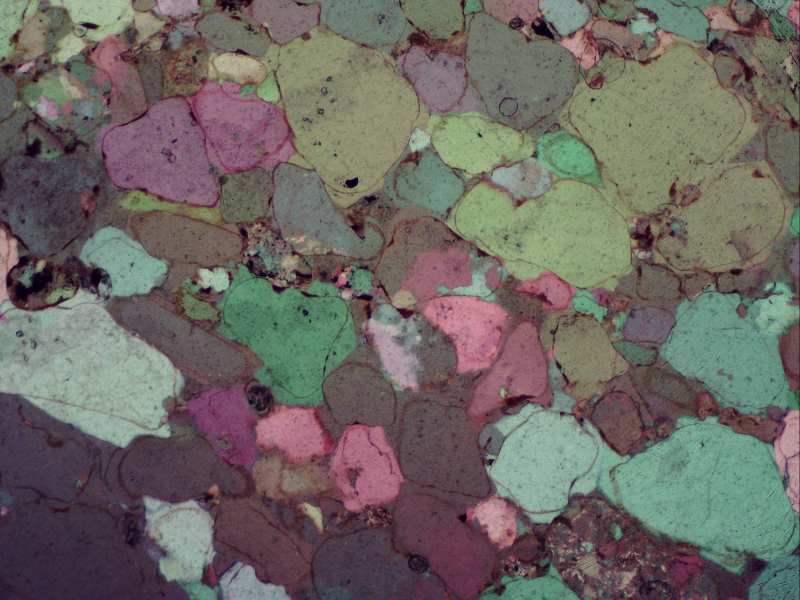Remaking Sandstone (aeolian) 19/Mar/2014 16:57
There is not a great deal of visual interest in Sandstone (aeolian) unless you are a geologist.
As Sandstone (aeolian) is one of the mineral slides in my collection I thought it only fair to give it some exposure. I took several photos using the 2x, 4x, 10x and 40x objectives.
The 2x objective just shows too much and is not very exciting. The 40x is beyond the resolution of the slide and even with stacked images the result is just fuzzy.
The four photo set show the examples from the four objectives.
I selected a 4x series to demonstrate the effects of a simple polarizing microscope. A standard compund microscope with one linear polarizing filter above the objectives and a second, the analyzer, above the light source.
Image 1 -2 is Limestone (aeolian) with crossed polarizers, 4x objective.
Not really exciting.
To spice up the image a little bit, I added an interference filter above the analyer. My interference filter is a plastic, flat bottomed petri dish.
When this filter is added it acts somewhat like another polarizer. There are minimum and maximum light transmission points.
Image 2 shows the interference filter at what I call the "0" position, or minimum light transmission.
Rotating the interference filter modifys the image. Interesting, but still not really special. The petri dish is just too uniform and optically clear.
My next interference filter was a piece of cellophane mangled into submission. The cellophane also shows the minimum and maximum transmission points.
But now the trnasmitted light creates a lot more interest.
Images 3, 4 show the cellophane filter rotated in two different positions.
There are so many good positions I made a short movie while rotating the cellophane.
The link is: http://carl.hennig.ca/Movies/L…..one39.html
And just for fun, I have added photos take with a 12mm Dark Field stop and yellow and blue Rheinberg stop.
So with a bit of effort, even Limestone (aeolian) can show a pretty face.
P.S. (aeolian)
The term refers specifically to the most common form of eolianite: coastal limestone consisting of carbonate sediment of shallow marine biogenic origin, formed into coastal dunes by the wind.

I apologize for the first post. Inserted images do not work
Remaking Sandstone (aeolian) 19/Mar/2014 16:57
There is not a great deal of visual interest in Sandstone (aeolian) unless you are a geologist.
As Sandstone (aeolian) is one of the mineral slides in my collection I thought it only fair to give it some exposure. I took several photos using the 2x, 4x, 10x and 40x objectives.
The 2x objective just shows too much and is not very exciting. The 40x is beyond the resolution of the slide and even with stacked images the result is just fuzzy.
The four photo set show the examples from the four objectives.

I selected a 4x series to demonstrate the effects of a simple polarizing microscope. A standard compund microscope with one linear polarizing filter above the objectives and a second, the analyzer, above the light source.
Image 1 -2 is Limestone (aeolian) with crossed polarizers, 4x objective.
Not really exciting.
To spice up the image a little bit, I added an interference filter above the analyer. My interference filter is a plastic, flat bottomed petri dish.
When this filter is added it acts somewhat like another polarizer. There are minimum and maximum light transmission points.
Image 2 shows the interference filter at what I call the "0" position, or minimum light transmission.

Rotating the interference filter modifys the image. Interesting, but still not really special. The petri dish is just too uniform and optically clear.
My next interference filter was a piece of cellophane mangled into submission. The cellophane also shows the minimum and maximum transmission points.
But now the trnasmitted light creates a lot more interest.
Images 3, 4 show the cellophane filter rotated in two different positions.


There are so many good positions I made a short movie while rotating the cellophane.
 The link is: http://carl.hennig.ca/Movies/L…..one39.html
The link is: http://carl.hennig.ca/Movies/L…..one39.html
And just for fun, I have added photos take with a 12mm Dark Field stop and yellow and blue Rheinberg stop.


So with a bit of effort, even Limestone (aeolian) can show a pretty face.
P.S. (aeolian)
The term refers specifically to the most common form of eolianite: coastal limestone consisting of carbonate sediment of shallow marine biogenic origin, formed into coastal dunes by the wind.

Most Users Ever Online: 149
Currently Online:
8 Guest(s)
Currently Browsing this Page:
1 Guest(s)
Member Stats:
Guest Posters: 31
Members: 593
Moderators: 0
Admins: 1
Forum Stats:
Groups: 2
Forums: 18
Topics: 1403
Posts: 5585
Newest Members: mariareese, Habibie, EoinFirestorm, Peniko177, Microseeshirt, SteveRichfield
Moderators:
Administrators: Oliver (201)


 Home
Home
 Offline
Offline




